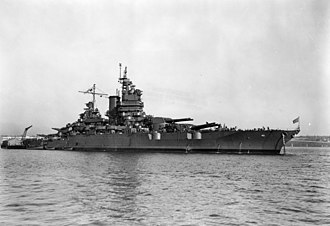USS New Mexico (BB-40)
|
|
|
| history |
|
|---|---|
| Keel laying: | October 14, 1915 |
| Launch: | April 13, 1917 |
| Commissioning: | May 20, 1918 |
| Removed from the register of ships: | July 19, 1946 |
| Fate: | sold for scrapping |
| General properties | |
| Displacement : | Construction: 32,000 ts |
| Length: | 190.0 m |
| Width: | 30.0 m |
| Draft: | 9.1 m |
| Speed: | 21 knots |
| Crew: | 1084 |
| Armament: | 12 × 14-inch (356 mm) guns, 14 × 5-inch (127 mm) guns, 4 × 3-inch (76 mm) guns, 2 × 21-inch torpedo tubes |
The USS New Mexico (BB-40) was an American battleship of New Mexico-class battleship and the first ship in the history of the United States Navy , which in honor of the 47th US state was named. She was the lead ship of the New Mexico class.
history
The construction of the USS New Mexico was approved by the Congress Act of June 30, 1914 and the construction contract was awarded a few months later, on October 30, 1914. The shipyard was the New York Naval Shipyard , where the keel was laid on October 14, 1915 and the launch took place on April 13, 1917 . The USS New Mexico , along with the USS Mississippi and the USS Idaho, was an improved successor to the Nevada-class and the Pennsylvania-class . Of active hostilities of the First World War took USS New Mexico does not participate more.
During various missions in the Second World War from 1944 to 1945, the battleship in the Pacific received two kamikaze hits, among other things . Finally, the USS New Mexico was decommissioned on July 19, 1946 in Boston and removed from the ship register on May 25, 1947 . It was sold to the Lipsett Co. on November 9, 1947 and scrapped in Newark from November 24, 1947 to July 1948 .
technology
The 32,000 ton battleship was put into service on May 20, 1918. The ship was 190.0 meters long, 30.0 meters wide and had a draft of 9.1 meters. The crew was 1084 men. The armor thickness of the ship was 76 mm in the deck, up to 356 mm in the side armor, 343 mm on the barbeds, and 406 mm in the command tower.
Originally the USS New Mexico was still intended for a conventional direct turbine drive. Instead, it became a prototype for the turbo-electric propulsion with a Melville-MacAlpine transmission after good results had been achieved on test ships. With the turbo-electric drive, the two steam turbines were directly coupled to two generators , each with an output of 12,500 kVA at 4242 volts . This fed the four propeller motors with an output of 5200 kW each. The steam was supplied by nine oil-fired boilers. The ship reached a maximum speed of 21 knots. A disadvantage of this drive method was the greater mass of around 55 kg / WPs compared to 30 to 40 kg / WPs with direct turbine drive and the greater space required by the systems.
At the beginning of the 1930s, all ships in the New Mexico class received four Westinghouse geared turbines with a total of 29,440 kW output and four new White Forster boilers as a replacement for the turbo-electric drive.
Armament
The armament against sea targets consisted of twelve 14-inch and initially 22 5-inch guns, which were reduced to 14 in 1922. As anti-aircraft armament , eight 3-inch guns were on board, which were replaced by the same number of 5-inch (12.7 cm) anti-aircraft guns during a modernization that lasted from March 1931 to January 1933 . In 1940, twelve 2.8-cm were also machine guns installed in Vierling guns.
Furthermore, the ship had three seaplanes and a total of two aircraft catapults .
Awards
The New Mexico was awarded six Battle Stars for service in World War II .

